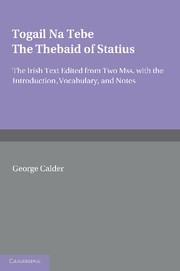Statius and Virgil
At the end of the Thebaid, Statius enjoins his epic 'not to compete with the divine Aeneid but rather to follow at a distance and always revere its footprints'. The nature of the Thebaid's interaction with the Aeneid is, however, a matter of debate. This 2007 book argues that the Thebaid reworks themes, scenes, and ideas from Virgil in order to show that the Aeneid's representation of monarchy is inadequate. It also demonstrates how the Thebaid's fascination with horror, spectacle, and unspeakable violence is tied to Statius' critique of the moral and political virtues at the heart of the Aeneid. Professor Ganiban offers both a way to interpret the Thebaid and a largely sequential reading of the poem.
- Provides a general interpretative approach to the Thebaid
- Offers an excellent introduction to the study and interpretation of the poem
- Translates all Latin passages in full
Product details
September 2010Paperback
9780521169110
270 pages
229 × 152 × 15 mm
0.4kg
Available
Table of Contents
- Preface
- List of abbreviations
- 1. Introduction
- 2. Oedipus' curse
- 3. Horror, prophecy, and the gods
- 4. Hypsipyle's narrative of nefas
- 5. Bacchus and the outbreak of war
- 6. Dis and the domination of hell
- 7. Delay and the rout of Pietas
- 8. Spectacle, crime, and monarchy at Thebes
- 9. Pietas, burial, and clementia in a world of nefas
- Works cited
- Indexes.





